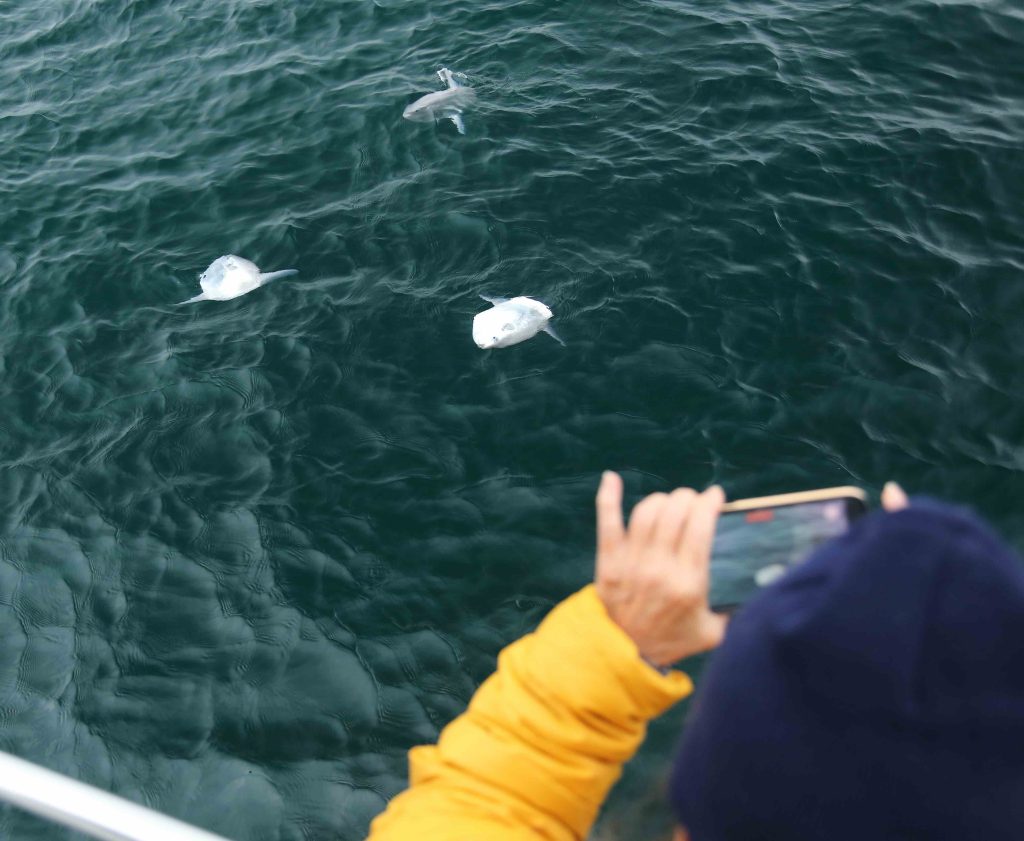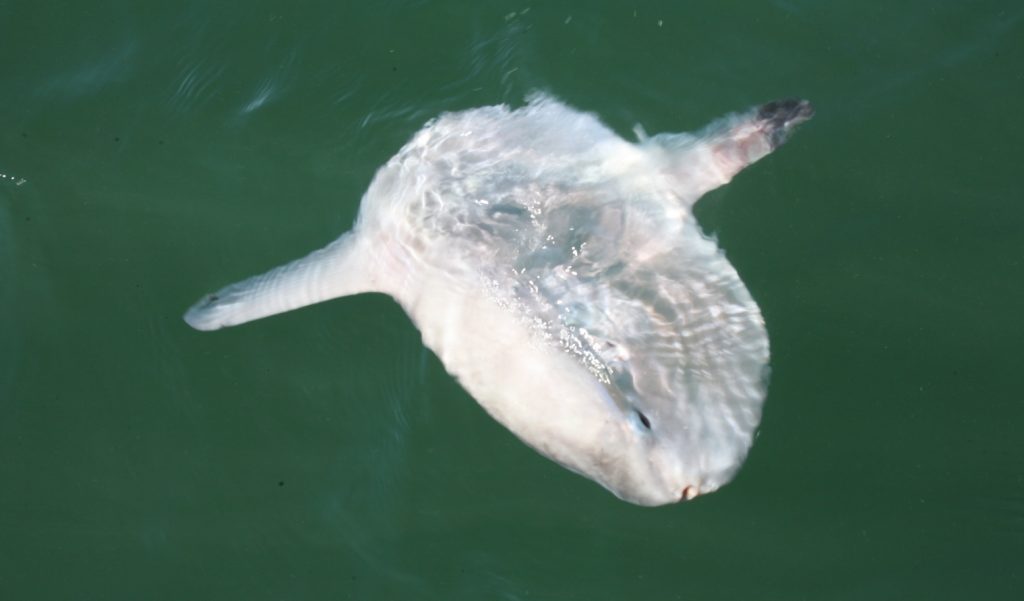Crossing the Gulf of the Farallones is always an eventful experience. Currents and tides aggregate plankton and planktivorous (plankton-eating) fish, which in turn attract harbor porpoises, seabirds and humpback whales. The rich seawater upwelled from the deep waters, feeds a proliferation of plankton, attracting marine life from across the Pacific into the Sanctuary waters. One of the most unusual fish is the giant ocean sunfish.
The ocean sunfish, or the Mola mola, is one of the largest bony fish in the world. The body length of adults can reach 3.3 meters (14 feet) typically weighing between 500 and 2,205 pounds.
Sunfish look like a giant swimming head without a tail. They are often observed at the surface, lying on their sides with large dorsal and anal fins flapping gently. The body is flattened laterally, and nearly oval in shape.
Instead of a caudal (tail) fin, sunfish have a unique shortened tail fin called a clavus. Not actively used in swimming, the Clavus serves more as a rudder. To swim they wave their dorsal and anal fins in synchrony when upright. The small pectoral fins are used primarily to stabilize. They can also slowly swim when on their side, where they are often observed at the surface. When upright, the three foot dorsal fin of a large Mola, can almost be mistaken for that of a shark.
Members of the pufferfish family, in the order Tetraodontiformes, these highly specialized fish are related to pufferfish, porcupinefish, and filefish. Following the extinction of the dinosaurs, Molas emerged between 45 million and 35 million years ago, about the same time as hammerhead sharks. Adult ocean sunfish are found in temperate and tropical oceans across the globe. They frequent the open ocean but occasionally venture nearshore where their prey concentrates and to breed. In the tropics, they have been observed in groups on coral reefs to have their parasites removed by cleaner wrasse.

Stage of development of Mola mola, larval, fry , juvenile. Source NOAA
Fertilization of eggs is external, so adult Molas aggregate during mating season to broadcast spawn sperm and eggs. Female ocean sunfish can produce over 300 million eggs each breeding season, making them the most fecund of all living vertebrates. In California, the adult fish appear in the spring through the fall and into the early winter. The eggs hatch together, making a feast for forage fish like sardines, seabirds and other planktivores. Protected by spines, the newly hatched larvae develop quickly and juveniles swim together for protection from predators. Young fish grow rapidly, achieving adult size by 15 months. The lifespan of ocean sunfish is currently unknown, but a sister species has been estimated to live 85-105 years.

The Hawaiian names for mola include: Kaumakanui which literally translates to big eyes placed on it; Kunehi apahu (cut off) and Kunehi makua (king). It was considered bad luck to catch and kill the Mola, because this would deter the true mackerel from finding their way to the islands, and to the fishermen’s nets. Evidence of ear bones (ossicles) found at native American middens in the southern Channel Islands of California indicate these fish were an important food source to the coastal people, thousands of years before colonization.
Adult sunfish are predators that feed on jellyfish and salps that are abundant in the rich waters of the California Coastal Upwelling system. They also consume small fish, fish larvae, squid, and pelagic crustaceans. Once thought to be the primary prey of sunfish, jellyfish make up only 15% of a sunfish’s diet. The fish have been described undergoing a diel (daily) vertical migration to deeper waters to seek their prey, and it is believed they rest at the surface “sunning” to warm the core temperature after diving the cold waters of the depths. More common in the photic zone, they have been recorded at depths of almost 1500 feet.

Threats
The sunfish are prey to sea-lions, seals, orcas, and sharks. Some humans eat the flaccid fish, which is considered a delicacy in some parts of the world, including the Philippines, Korea, Taiwan and Japan. Like their cousins the pufferfish, the flesh of these fish may contain biotoxins, and can accumulate toxins like organic mercury.
Threats include pollution, loss of productive habitat, increased sea surface temperatures from climate change, and bycatch. Sunfish are frequently caught in gillnets and seines and discarded. Sunfish have not been evaluated by the IUCN. They have been frequently caught as bycatch by drift gillnet and setnet fisheries off California. In southern California, ocean sunfish compromised 29% of the catch in drift gillnet fisheries targeting swordfish until that gear was banned in 2022.
Learn more about sunfish science at https://oceansunfish.org.
References
Coastal Fishes of the Pacific Northwest, Revised and Expanded Second Edition Lamb, Andy; Edgell, Phil Harbour Publishing, 2010 ISBN 10: 1550174711ISBN 13: 9781550174717
Liu, K., M. Lee, S. Joung, Y. Chang. 2009. Age and growth estimates of the sharptail mola, Masturus lanceolatus, in waters of eastern Taiwan. Fisheries Research, 95/2-3: 154-160.
Pope, E., G. Hays, T. Thys, T. Doyle, D. Sims, N. Queiroz, V. Hobson, L. Kubicek, J. Houghton. 2010. The biology and ecology of the ocean sunfish Mola mola: a review of current knowledge and future research perspectives. Reviews in Fish Biology and Fisheries, 20/4: 471-487.
Margaret Titcomb, author of Native Use of Fish in Hawai’i
J. Porcasi and S. Andrews (2001) Evidence for a Prehistoric Mola mola fishery on the Southern California Coast, Journal of California and Great Basin Archaeology, Vol 23 No 1.
Sawai, E. et al (2017). Redescription of the bump-head sunfish Mola alexandrini (Ranzani 1839), senior synonym of Mola ramsayi (Giglioli 1883), with designation of a neotype for Mola mola (Linnaeus 1758) (Tetraodontiformes: Molidae), Ichthyological Research DOI 10.1007/s10228-017-0603-6
Cartamil, D., C. Lowe. 2004. Diel movement patterns of Ocean Sunfish Mola mola off Southern California. Mar. Ecol. Prog. Ser., 266: 245-253.